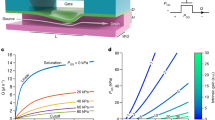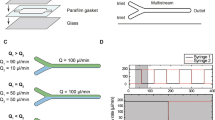Abstract
A passive microfluidic delivery system using hydrophobic valving and pneumatic control was devised for microfluidic handling on a chip. The microfluidic metering, cutting, transport, and merging of two liquids on the chip were correctly performed. The error range of the accuracy of microfluid metering was below 4% on a 20 nL scale, which showed that microfluid was easily manipulated with the desired volume on a chip. For a study of the feasibility of biochemical reactions on the chip, a single enzymatic reaction, such as a β-galactosidase reaction was performed. The detection limit of the substrate,i.e. fluorescein di-β-galactopyranoside (FDG) of the β-galactosidase (6.7 fM), was about 76 pM. Additionally, multiple biochemical reactions such asin vitro protein synthesis of enhanced green fluorescence protein (EGFP) were successfully demonstrated at the nanoliter scale, which suggests that our microfluidic chip can be applied not only to miniaturization of various biochemical reactions, but also to development of the microfluidic biochemical reaction system requiring a precise nano-scale control.
Similar content being viewed by others
References
Reyes, D. R., D. Iossifidis, P. A. Auroux, and A. Manz (2002) Micro total analysis systems. 1. Introduction, theory, and technology.Anal. Chem. 74: 2623–2636.
Auroux, P. A., D. Iossifidis, D. R. Reyes, and A. Manz (2002) Micro total analysis systems. 2. Analytical standard operations and applications.Anal. Chem. 74: 2637–2652.
Zhao, B., J. S. Moore, and D. J. Beebe (2001) Surface-directed liquid flow inside microchannels.Science 291: 1023–1026.
Ocvirk, G., M. Munroe, T. Tang, R. Oleschuk, K. Westra, and D. J. Harrison (2000) Electrokinetic control of fluid flow in native poly(dimethylsiloxane) capillary electrophoresis devices.Electrophoresis 21: 107–115.
Gallardo, B. S., V. K. Gupta, F. D. Eagerton, L. I. Jong, V. S. Craig, R. R. Shah, and N. L. Abbott (1999) Electrochemical principles for active control of liquids on submillimeter scales.Science 283: 57–60.
Unger, M. A., H. P. Chou, T. Thorsen, A. Scherer, and S. R. Quake (2000) Monolithic microfabricated valves and pumps by multilayer soft lithography.Science 288: 113–116.
Handique, K., D. T. Burke, C. H. Mastrangelo, and M. A. Burns (2001) On-chip thermopneumatic pressure for discrete drop pumping.Anal. Chem. 73: 1831–1838.
Terray, A., J. Oakey, and D. W. Marr (2002) Microfluidic control using colloidal devices.Science 296: 1841–1844.
Zhao, B., J. S. Moore, and D. J. Beebe (2002) Principles of surface-directed liquid flow in microfluidic channels.Anal. Chem. 74: 4259–4268.
Hong, J. W., V. Studer, G. Hang, W. F. Anderson, and S. R. Quake (2004) A nanoliter-scale nucleic acid processor with parallel architecture.Nat. Biotechnol. 22:435–439.
Liu, J., C. Hansen, and S. R. Quake (2003) Solving the “world-to-chip” interface problem with a microfluidic matrix.Anal. Chem. 75: 4718–23.
Paik, P., V. K. Pamula, M. G. Pollack, and R. B. Fair (2003) Electrowetting-based droplet mixers for microfluidic systems.Lab Chip 3: 28–33.
Srinivasan, V., V. K. Pamula, and R. B. Fair (2004) Droplet-based microfluidic lab-on-a-chip for glucose detection.Anal. Chim. Acta 507: 145–150.
Cho, S. K., H. J. Moon, and C. J. Kim (2003) Creating, transporting, cutting, and merging liquid droplets by electrowetting-based actuation for digital microfluidic circuits.J. Microelectromech. Syst. 12: 70–80.
Lee, C. S., S. H. Lee, S. S. Park, Y. K. Kim, and B. G. Kim (2003) Protein patterning on silicon-based surface using background hydrophobic thin film.Biosens. Bioelectron. 18: 437–444.
Lee, S. H., C. S. Lee, B. G. Kim, and Y. K. Kim (2003) Quantitatively controlled nanoliter liquid manipulation using hydrophobic valving and control of surface wettability.J. Micromech. Microeng. 13: 89–97.
Lee, S. H., S. I. Cho, C. S. Lee, B. G. Kim, and Y. K. Kim (2005) Microfluidic chip for biochemical reaction and electrophoretic separation by quantitative volume control.Sens. Actuators B Chem. 110: 164–173.
Mrksich, M., C. S. Chen, Y. Xia, L. E. Dike, D. E. Ingber, and G. M. Whitesides (1996) Controlling cell attachment on contoured surfaces with self-assembled monolayers of alkanethiolates on gold.Proc. Natl. Acad. Sci. USA 93: 10775–10778.
Li, B. M. and D. Y. Kwok (2003) A lattice Boltzmann model for electrokinetic microchannel flow of electrolyte solution in the presence of external forces with the Poisson-Boltzmann equation.Int. J. Heat Mass Tran. 46: 4235–4244.
Park, S. S., H. S. Joo, S. I. Cho, M. S. Kim, Y. K. Kim, and B. G. Kim (2003) Multi-step reactions on microchip platform using nitrocellulose membrane reactor.Biotechnol. Bioprocess Eng. 8: 257–262.
Labrousse, H., J. L. Guesdon, J. Ragimbeau, and S. Avrameas (1982) Miniaturization of beta-galactosidase immunoassays using chromogenic and fluorogenic substrates.J. Immunol. Methods 48: 133–147.
Wu, C. F., H. J. Cha, G. Rao, J. J. Valdes, and W. E. Bentley (2000) A green fluorescent protein fusion strategy for monitoring the expression, cellular location, and separation of biologically active organophosphorus hydrolase.Appl. Microbiol. Biotechnol. 54: 78–83.
Johnvesly, B., D. G. Kang, S. S. Choi, J. H. Kim, and H. J. Cha (2004) Comparative production of green fluorescent protein under co-expression of bacterial hemoglobin inEscherichia coli W3110 using different culture scales.Biotechnol. Bioprocess Eng. 9: 274–277.
Stiege, W. and V. A. Erdmann (1995) The potentials of thein vitro protein biosynthesis system.J. Biotechnol. 41: 81–90.
Ahn, J. H., C. Y. Choi, and D. M. Kim (2005) Effect of energy source on the efficiency of translational termination during cell-free protein synthesis.Biochem. Biophys. Res. Commun. 337: 325–329.
Kim, D. M., T. Kigawa, C. Y. Choi, and S. Yokoyama (1996) A highly efficient cell-free protein synthesis system from Escherichia coli.Eur. J. Biochem. 239: 881–886.
Author information
Authors and Affiliations
Corresponding author
Rights and permissions
About this article
Cite this article
Lee, CS., Lee, SH., Kim, YG. et al. Biochemical reactions on a microfluidic chip based on a precise fluidic handling method at the nanoliter scale. Biotechnol. Bioprocess Eng. 11, 146–153 (2006). https://doi.org/10.1007/BF02931899
Received:
Accepted:
Issue Date:
DOI: https://doi.org/10.1007/BF02931899




